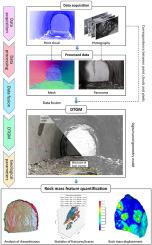Digital tunnel geometry model (DTGM): A multimodal data fusion framework for rock mass feature quantification
IF 7.5
1区 工程技术
Q1 ENGINEERING, GEOLOGICAL
International Journal of Rock Mechanics and Mining Sciences
Pub Date : 2025-07-09
DOI:10.1016/j.ijrmms.2025.106212
引用次数: 0
Abstract
Accurate acquisition of rock mass parameters in complex tunnel environments remains challenging due to limitations of conventional non-contact measurement techniques. This study introduces a novel digital tunnel geometry model (DTGM) framework designed to address the limitations associated with reliance on a single data source. By implementing multi-source data fusion of LiDAR and photogrammetric measurements, the DTGM achieves millimeter-level geometric accuracy in rock mass characterization. In the study, three innovative contributions are introduced: (1) an automated robust denoising algorithm for tunnel point clouds, (2) a surface reconstruction optimization algorithm emphasizing the preservation of rock mass morphological undulations and fracture structures, and (3) a parametric data fusion methodology coupling geometric models with rock mass attributes. Comparative analysis shows that the proposed method offers higher computational efficiency and reconstruction quality. Case studies validate the effectiveness of the proposed framework in acquiring critical rock mass parameters, showing 51 % (dip direction) and 58 % (dip angle) improvement in discontinuity analysis accuracy over traditional point cloud inputs. The quantification of fracture/trace plane parameters overcomes the inherent limitation of dimensional deficiency in image-based 3D modeling. Results establish the engineering superiority of the DTGM in rock mass parameter resolution and quantitative analysis while also advancing digital twin implementation through a novel virtual modeling paradigm.

数字隧道几何模型(DTGM):岩体特征量化的多模态数据融合框架
由于传统的非接触式测量技术的局限性,在复杂的隧道环境中准确获取岩体参数仍然具有挑战性。本研究介绍了一种新的数字隧道几何模型(DTGM)框架,旨在解决与依赖单一数据源相关的限制。通过实现激光雷达和摄影测量的多源数据融合,DTGM在岩体表征方面达到了毫米级的几何精度。在研究中,介绍了三个创新贡献:(1)隧道点云的自动鲁棒去噪算法;(2)强调保存岩体形态波动和断裂结构的表面重建优化算法;(3)耦合几何模型和岩体属性的参数数据融合方法。对比分析表明,该方法具有较高的计算效率和重构质量。实例研究验证了所提出框架在获取关键岩体参数方面的有效性,表明与传统点云输入相比,不连续分析精度提高了51%(倾斜方向)和58%(倾角)。断口/迹面参数的量化克服了基于图像的三维建模固有的尺寸不足的局限性。研究结果确立了DTGM在岩体参数解析和定量分析方面的工程优势,同时通过一种新的虚拟建模范式推进了数字孪生的实现。
本文章由计算机程序翻译,如有差异,请以英文原文为准。
求助全文
约1分钟内获得全文
求助全文
来源期刊
CiteScore
14.00
自引率
5.60%
发文量
196
审稿时长
18 weeks
期刊介绍:
The International Journal of Rock Mechanics and Mining Sciences focuses on original research, new developments, site measurements, and case studies within the fields of rock mechanics and rock engineering. Serving as an international platform, it showcases high-quality papers addressing rock mechanics and the application of its principles and techniques in mining and civil engineering projects situated on or within rock masses. These projects encompass a wide range, including slopes, open-pit mines, quarries, shafts, tunnels, caverns, underground mines, metro systems, dams, hydro-electric stations, geothermal energy, petroleum engineering, and radioactive waste disposal. The journal welcomes submissions on various topics, with particular interest in theoretical advancements, analytical and numerical methods, rock testing, site investigation, and case studies.

 求助内容:
求助内容: 应助结果提醒方式:
应助结果提醒方式:


